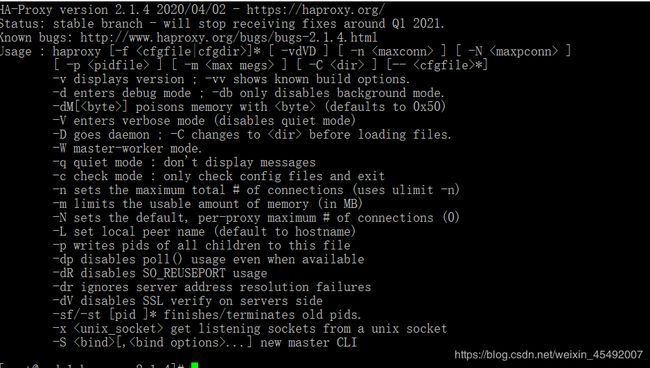RabbitMQ:搭建Haproxy+RabbitMQ集群方式(完成)
当前的版本:rabbitmq 3.8.3、haproxy 1.5.18
1.声明
当前内容用于本人学习和复习之用,内容包括haproxy的编译、配置rabbitmq以及其中发现的问题(基于本地的VM 中的Linux、CentOS7)
2.安装haproxy
yum install -y haproxy
此时使用haproxy
3.启动集群
| 节点 | 节点ip |
|---|---|
| node2 | 192.168.1.104 |
| node3 | 192.168.1.107 |
4.配置Haproxy到RabbitMQ集群
Haproxy搭建的地址在:192.168.1.100
1.直接编辑(使用yum安装后的haproxy的配置文件在/etc/haproxy/haproxy.cfg)
vi /etc/haproxy/haproxy.cfg
2.开始编写haproxy.cfg文件
#---------------------------------------------------------------------
# Example configuration for a possible web application. See the
# full configuration options online.
#
# http://haproxy.1wt.eu/download/1.4/doc/configuration.txt
#
#---------------------------------------------------------------------
#---------------------------------------------------------------------
# Global settings
#---------------------------------------------------------------------
global
# to have these messages end up in /var/log/haproxy.log you will
# need to:
#
# 1) configure syslog to accept network log events. This is done
# by adding the '-r' option to the SYSLOGD_OPTIONS in
# /etc/sysconfig/syslog
#
# 2) configure local2 events to go to the /var/log/haproxy.log
# file. A line like the following can be added to
# /etc/sysconfig/syslog
#
# local2.* /var/log/haproxy.log
#
log 127.0.0.1 local2
chroot /var/lib/haproxy
pidfile /var/run/haproxy.pid
maxconn 4000
user haproxy
group haproxy
daemon
# turn on stats unix socket
stats socket /var/lib/haproxy/stats
#---------------------------------------------------------------------
# common defaults that all the 'listen' and 'backend' sections will
# use if not designated in their block
#---------------------------------------------------------------------
defaults
mode http
log global
option httplog
option dontlognull
option http-server-close
option forwardfor except 127.0.0.0/8
option redispatch
retries 3
timeout http-request 10s
timeout queue 1m
timeout connect 10s
timeout client 1m
timeout server 1m
timeout http-keep-alive 10s
timeout check 10s
maxconn 3000
#---------------------------------------------------------------------
# main frontend which proxys to the backends
#---------------------------------------------------------------------
# 开启前端可以通过 ip地址:15672方式访问app中的地址(fronted主要用于前端的显示)
frontend main *:15672
acl url_static path_beg -i /static /images /javascript /stylesheets
acl url_static path_end -i .jpg .gif .png .css .js
use_backend static if url_static
default_backend app
#---------------------------------------------------------------------
# static backend for serving up images, stylesheets and such
#---------------------------------------------------------------------
backend static
balance roundrobin
server static 127.0.0.1:4331 check
##
# haproxy 的管理页面
#
listen admin_stats *:8090 #为haproxy访问状态监控页面配置,取名为admin_stats
stats enable #启用监听端口
mode http #http的7层模式
log global # 继承global中log的定义
stats uri /stats #监控页面的url访问路径,即http://ip/stats访问监控页面
stats realm Haproxy\ Statistics #监控页面的密码框提示信息
stats auth admin:admin #监控页面的用户和密码admin,可以设置多个用户名
#stats hide-version #隐藏统计页面上HAProxy的版本信息
stats admin if TRUE #当通过认证才可管理
stats refresh 30s #页面自动刷新时间30s
#---------------------------------------------------------------------
# round robin balancing between the various backends
#---------------------------------------------------------------------
# 配置前端的负载均衡
backend app
balance roundrobin
server app1 192.168.1.104:15672 check inter 2000 fall 5
server app2 192.168.1.107:15672 check inter 2000 fall 5
#server app3 127.0.0.1:5003 check
#server app4 127.0.0.1:5004 check
# 开启一个端口本地ip:5672方式用于访问后面的节点对应的地址(注意对于tcp需要使用listen)
listen rabbit_servers *:5672
mode tcp
balance roundrobin
server rabbit_node2 192.168.1.104:5672 check inter 2000 fall 5
server rabbit_node3 192.168.1.107:5672 check inter 2000 fall 5
3.启动当前的haproxy
haproxy -f haproxy.cfg
注意前面配置文件中的端口的开放
查看界面结果:http://192.168.1.108:8090/stats
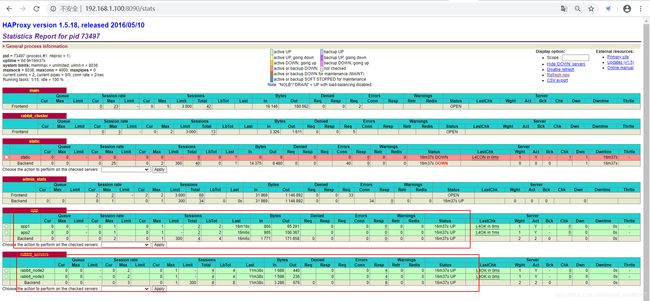
此时可以发现当前的haproxy是启动成功的,并且可以访问两个节点,当前的节点是成功的
5.测试15672是否可以访问
直接访问:http://192.168.1.100:15672/api/index.html
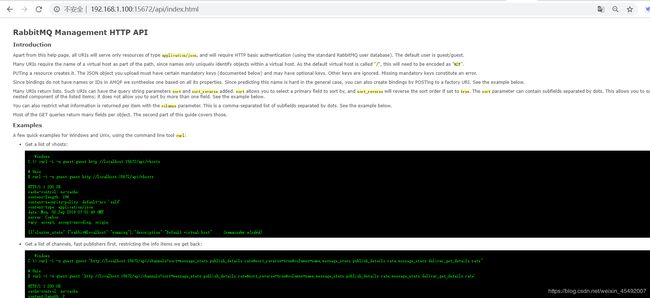
此时发现当前的15672界面是可以访问到其他页面的
测试当前的5672端口是否可以访问
通过ui界面在node3节点中添加node3Queue的queue
创建消费者:
package com.hy.rabbitmq.connection.cluster.normal;
import java.io.IOException;
import java.util.concurrent.TimeoutException;
import com.hy.rabbitmq.connection.utils.RabbitMqUtils;
import com.hy.rabbitmq.connection.utils.StringUtils;
import com.rabbitmq.client.BuiltinExchangeType;
import com.rabbitmq.client.Channel;
import com.rabbitmq.client.Connection;
import com.rabbitmq.client.DefaultConsumer;
import com.rabbitmq.client.Envelope;
import com.rabbitmq.client.AMQP.BasicProperties;
import com.rabbitmq.client.AMQP.Exchange.DeclareOk;
/**
* @description 消费者专门消费node2中的消息
* @author admin
*
*/
public class ClusterNode2MsgComsumer {
private static String host = "192.168.1.100";
private static int port = 5672;
private static String username = "root";
private static String password = "root";
public static void main(String[] args) throws IOException {
RabbitMqUtils mqUtils = new RabbitMqUtils(host, port , username, password );
String queueName = "node3Queue";
Connection connection = mqUtils.getConnection();
Channel channel = connection.createChannel();
channel.basicConsume(queueName, true, new DefaultConsumer(channel) {
@Override
public void handleDelivery(String consumerTag, Envelope envelope, BasicProperties properties, byte[] body)
throws IOException {
System.out.println("consumerTag==>" + consumerTag);
System.out.println("envelope==>" + envelope);
System.out.println("props==>" + properties);
System.out.println("消费者node2接收消息==>【" + StringUtils.toString(body) + "】");
}
});
}
}
启动消费者
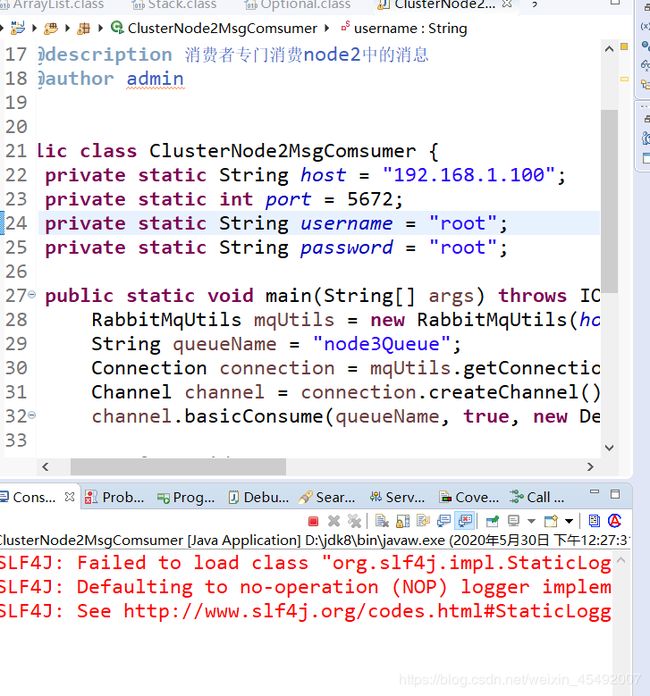
启动成功,此时再次查看当前的ui界面的Connection
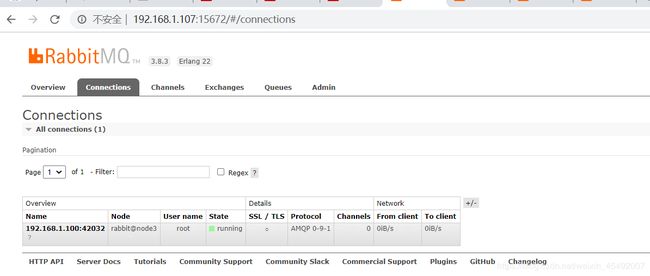
停止消费者然后再次启动发现实现了负载均衡
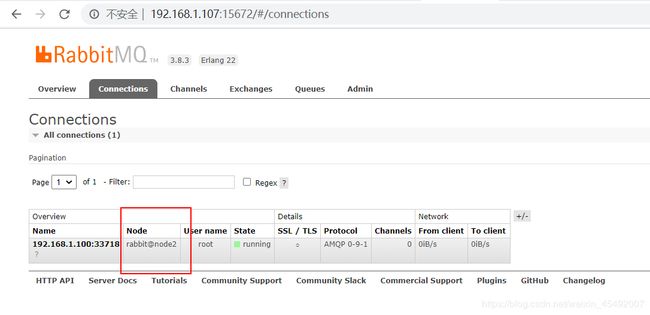
配置成功!
6.存在的问题
Cannot create pidfile /run/haproxy.pid,表示该文件已近存在了,直接使用rm /run/haproxy.pid即可删除,然后重新启动即可- 启动过程容易出现
Starting proxy admin_stats: cannot bind socket [0.0.0.0:8090],只要使用haproxy -f /etc/haproxy/haproxy.cfg,只要页面显示了就表示显示成功

- 注意在使用5672端口的时候需要使用listen来绑定
*:5672,不能使用backend,backend表示的是前端的,注意使用mode为tcp
7.总结
1.安装Haproxy是非常简单的,只需要执行yum install -y haproxy即可完成安装
2.主要就是需要编写当前的haproxy.cfg中的内容,小心5672的端口的编写必须是listen
3.对于使用servie haproxy start不能启动,需要分析日志文件,如果是bind端口的问题只需要使用haproxy - f /etc/haproxy/haproxy.cfg进行启动即可
4.弄了两天终于完成了,感概许多
以上纯属个人见解,如有问题请联本人!
